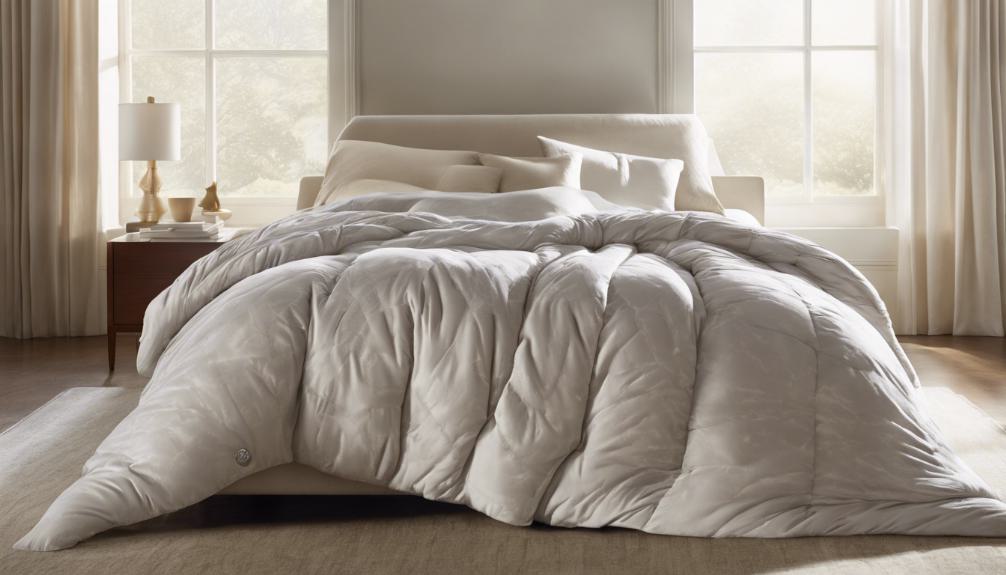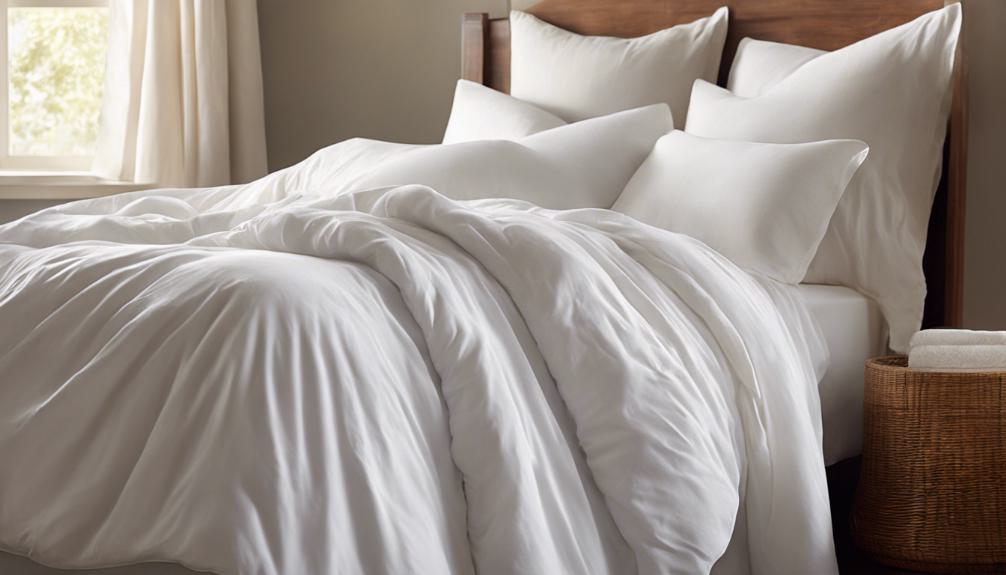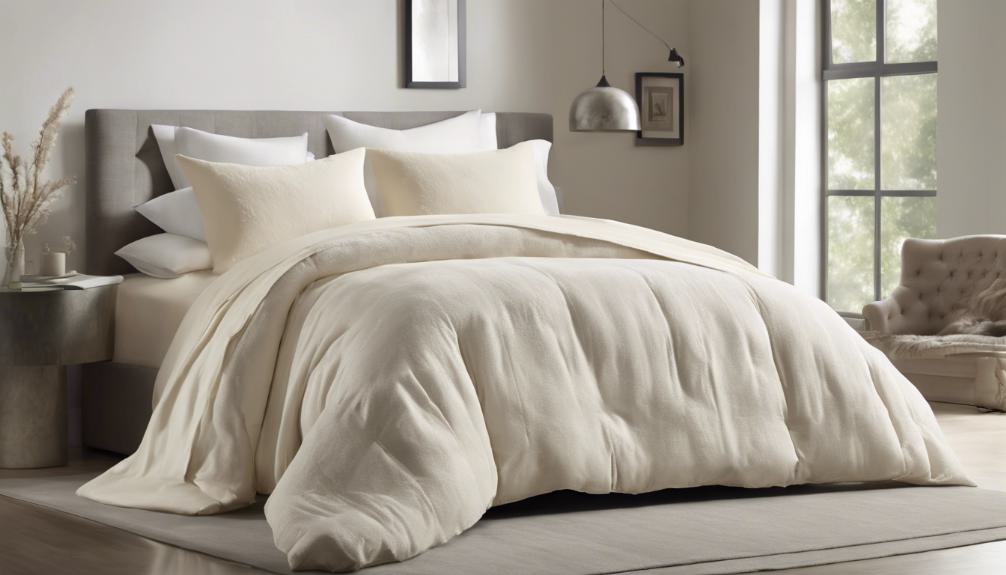How To Get Wrinkles Out Of a Comforter? A Step-By-Step Guide
Ever flopped onto bed, only to realize your comforter looks like it’s been through a spin cycle of chaos? Wrinkly comforters are a sneaky culprit behind less-than-relaxing vibes in the bedroom.
If you’re wondering how to get wrinkles out of a comforter, you’re in the right place! I’ve wrestled with those stubborn creases myself and found easy, practical solutions to make your bed look effortlessly smooth. Let’s tackle this common sleep struggle together!
How To Get Wrinkles Out Of a Comforter?

Wrinkles in a comforter often happen from prolonged storage or washing, leaving it looking more like a crumpled potato than a cozy bedspread.
To rescue your beloved bedding, toss it in the dryer with a damp cloth or a few ice cubes for 10-15 minutes, or try shaking and stretching it to smooth out those pesky creases! Additionally, using a wrinkle release spray can provide a quick fix for stubborn wrinkles. It’s also helpful to avoid overloading the machine when drying to ensure even drying and prevent further wrinkling.
How to Steam Your Comforter to Remove Wrinkles

If your comforter looks like it just survived a wrestling match, don’t worry! A handheld steamer can be your best friend in giving your bedding a fresh, wrinkle-free look without the hassle of a full wash.
It’s a simple process that can help maintain the comforter’s shape and color while also killing pesky dust mites and bacteria. Washing down comforters regularly can also contribute to a healthier sleeping environment. Ready to steam away those wrinkles? Let’s get started!
Preparing the Steamer
Begin by filling your handheld steamer with water.
After plugging it in, give it 20-25 seconds to warm up—perfect time for a quick stretch! If your outlet is playing hard to get, an extension cord works wonders.
Before you start steaming, press the steam button for a few seconds to get a feel for the steam flow. You want to be certain it’s ready to tackle those wrinkles! Hot steam effectively eliminates dust mites, ensuring a more hygienic bedding environment.
Steaming Technique
Hold your steamer about 10-15 cm away from the fabric to avoid any unfortunate burns.
Move it slowly over the wrinkled areas, like a gentle dance across the fabric. For the best results, pull the fabric tight with one hand while you steam with the other.
Just remember, delicate fabrics like silk deserve a little extra care, so don’t let the steamer get too close!
Safety and Fabric Considerations
Always check the laundry label before steaming! You don’t want to ruin a perfectly good comforter because it can’t handle the heat.
Fabrics like wool and down are generally safe, but steaming can be especially beneficial for wool to protect its lanolin layer and enhance its quality.
Just keep an eye on the steamer to avoid any prolonged contact that might cause damage.
Post-Steaming Care
Once you’ve steamed your comforter, allow it to dry thoroughly for about 30-60 minutes.
Hanging it up is a great way to air dry and ascertain no lingering moisture.
If you see any remaining wrinkles, a gentle patting motion with your hands can smooth them out.
Plus, steaming not only freshens up your bedding but also helps maintain its natural beauty! Regular steaming contributes to a healthier sleeping environment by reducing allergens.
Best Fabric for Comforters?

When choosing the best fabric for comforters, cotton often takes the crown. Its breathability keeps you cool and comfortable, making it a popular pick for those warm summer nights.
Plus, its soft touch is like a gentle hug, perfect for sinking into after a long day.
Bamboo is another contender worth considering. Not only is it incredibly breathable, but it also regulates temperature, making it a dream for those who tend to run hot. Additionally, bamboo comforters are naturally resistant to dust mites, contributing to a healthier sleeping environment.
And let’s not forget its eco-friendly credentials—Mother Nature approves!
If you’re after luxury, silk is the way to go. Its soft texture feels divine against the skin, and it’s hypoallergenic, making it great for allergy sufferers.
Just keep in mind that silk can be a bit high-maintenance—handle with care!
Lastly, don’t overlook alternative materials like eucalyptus or wool. They offer unique benefits like moisture-wicking properties and natural warmth.
With so many options, you’re sure to find a comforter that suits your sleeping style perfectly!
Ironing Techniques for Comforters

Ironing a comforter might sound like a chore, but with the right techniques, it can be a breeze!
Start by removing your comforter from the dryer while it’s still slightly damp. This makes ironing a lot easier and helps to banish those pesky wrinkles without too much effort. Regular care instructions should be followed for longevity and freshness of your bedding.
When it comes to the actual ironing, make sure to check the care label for heat settings. Use a steam iron or garment steamer, keeping it a few inches away from the fabric. Adjusting heat settings is essential to avoid damaging the fabric while achieving smooth results.
For stubborn wrinkles, try placing a damp towel under the comforter as you glide the iron over it.
And remember, focus on the visible sections for a polished look—no one needs to know about the wrinkles hiding underneath!
Care Tips for Comforters

Caring for your comforter is key to keeping it looking fresh and feeling cozy. By following a few straightforward tips, you can guarantee your comforter stays in tip-top shape.
Whether you’re washing, spot cleaning, or drying, knowing the right methods can extend the life of your bedding and keep those pesky wrinkles at bay. So, roll up your sleeves and let’s plunge into the best practices for maintaining your comforter!
Washing Your Comforter
When it comes to washing your comforter, always start by checking the care label for specific instructions.
If your comforter is protected by a duvet cover, aim to wash it 2-3 times a year; otherwise, every 1-2 months should do the trick. Washing your comforter helps to extend its life and reduce irritants that can affect your comfort.
Use a large-capacity washer to give your comforter ample room to move—nobody wants a cramped comforter!
Select a bulky or delicate wash cycle with cold or warm water and a mild, fragrance-free detergent to keep it clean without any harsh additives.
Frequently Asked Questions
Can I Use a Dryer to Remove Wrinkles From My Comforter?
Yes, you can definitely use a dryer to remove wrinkles from your comforter! I recommend the air-fluff setting with some dryer balls and a damp towel. It’s a simple and effective way to freshen it up without heat.
Is It Safe to Bleach My Comforter to Remove Wrinkles?
I wouldn’t suggest using bleach on your comforter for wrinkles. It can harm the fabric and filling. Instead, try steaming it or using a gentle wrinkle-release spray. These methods keep it fresh without the risk!
How Often Should I Wash My Comforter to Prevent Wrinkles?
I recommend washing your comforter 2-3 times a year if it has a cover. Without one, aim for monthly washes. Regular cleaning helps keep it fresh, but don’t overdo it to avoid wrinkles and wear.
Are There Specific Brands Known for Wrinkle-Resistant Comforters?
Check out Brooklinen and Buffy for wrinkle-resistant comforters. Their special materials keep your bedding looking fresh and neat with minimal effort. You’ll love how inviting your bed looks without the hassle!
Can I Hang My Comforter to Dry Without Getting Wrinkles?
Sure! I often hang my comforter to dry without stressing about wrinkles. Just smooth it out while it hangs and keep it out of direct sunlight. It relaxes nicely this way!
In Conclusion
Removing wrinkles from your comforter can be a simple task. You can use the dryer method with damp cloths for a quick fix or try a garment steamer for effective results. Additionally, a wrinkle release spray can help tackle those persistent creases.
Regular maintenance is key to keeping your comforter looking fresh. Check for any remaining wrinkles after your initial efforts, and don’t hesitate to repeat the process if needed. With these techniques, you’ll be able to enjoy a smooth and cozy comforter in no time. Give these methods a try and experience the difference!
